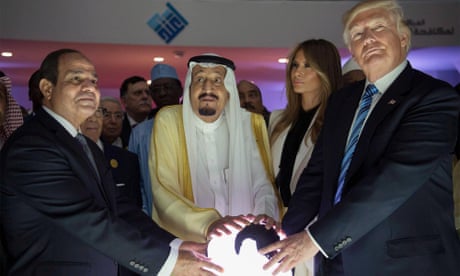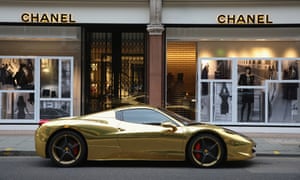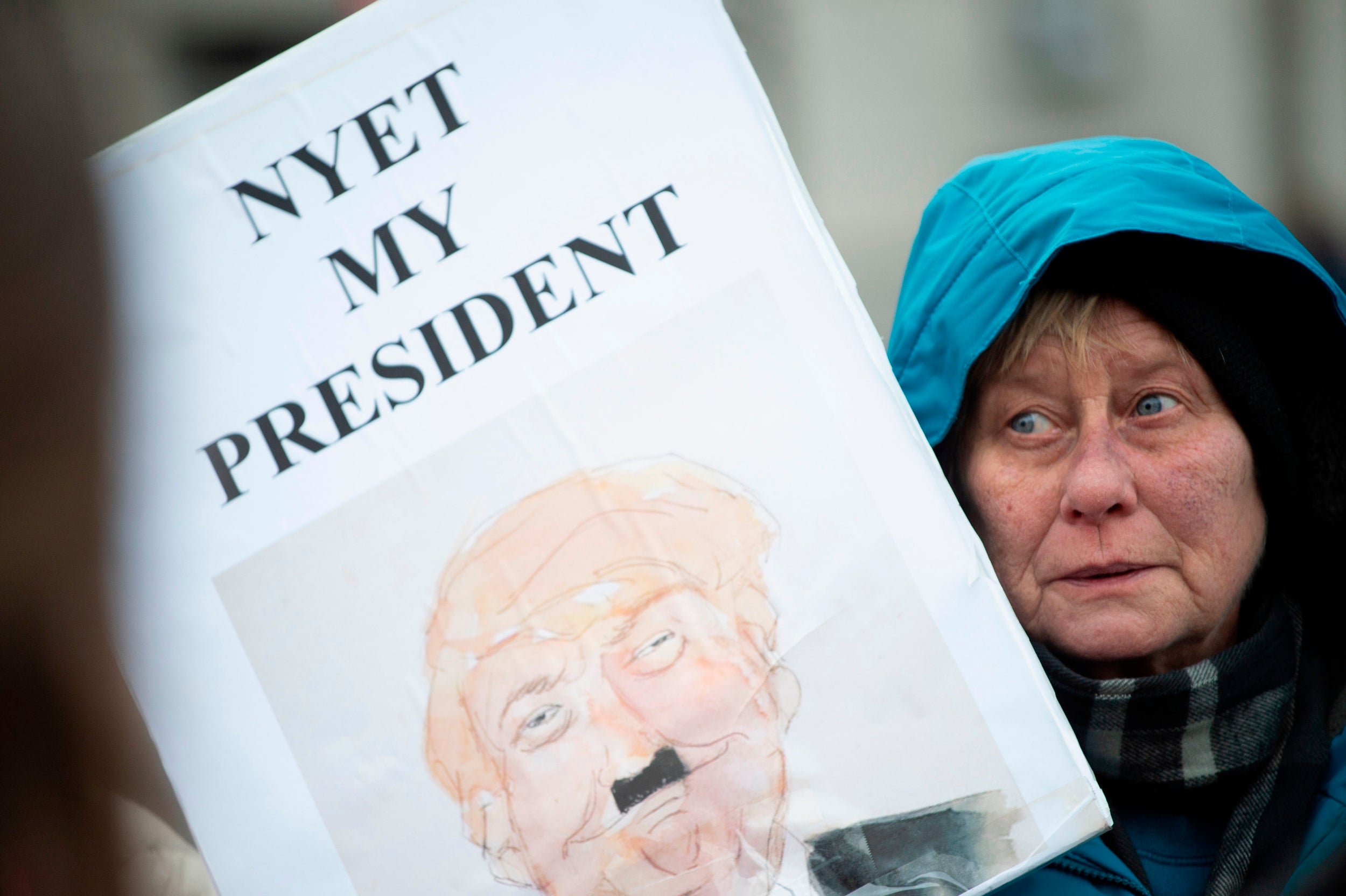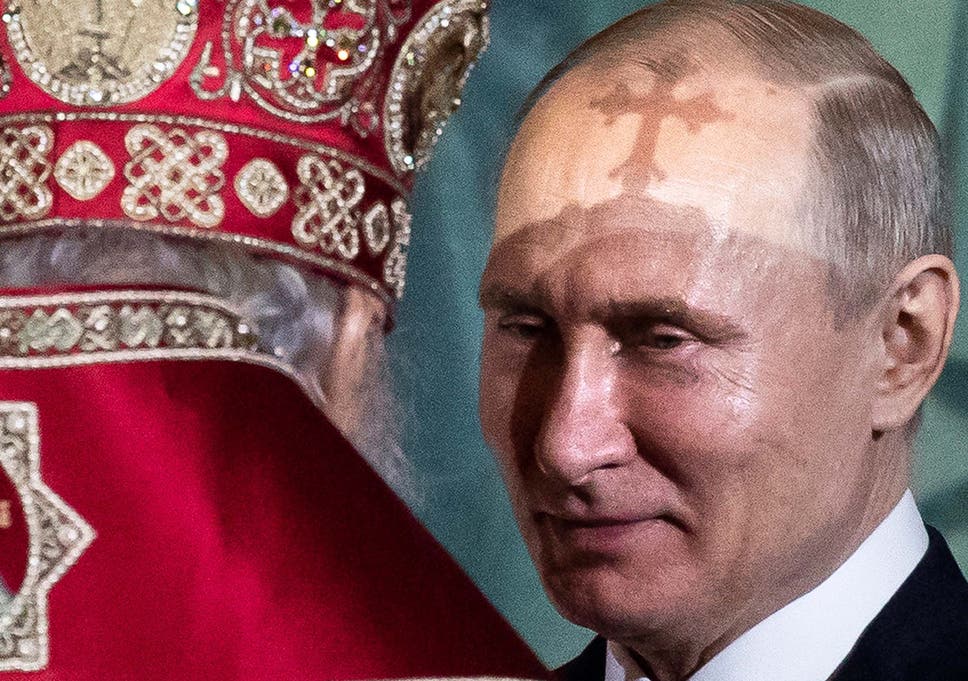Saudis gave gadget that briefly captivated the internet to the US – but embassy officials fearful of scandal soon hid it away
Martin Pengelly in New York @MartinPengelly
Wed 4 Mar 2020 THE GUARDIAN
VIDEO
Donald Trump touches glowing orb to open anti-terrorism centre
The mysterious glowing orb which Donald Trump, King Salman and Abdel Fatah al-Sisi clutched in Riyadh in May 2017 is now in US possession, according to a new book – but is hidden away for fear of causing a scandal.
The bizarre factoid is contained in MBS, a new book by the New York Times correspondent Ben Hubbard about the Saudi crown prince, Mohammed bin Salman, which will be published next week. The Guardian obtained a copy.

'One orb to rule them all': image of Donald Trump and glowing globe perplexes internet
Hubbard recounts the crown prince’s rise to power and his ruthless suppression of rivals; his direction of Saudi foreign policy including the war in Yemen; and his links to the October 2018 murder in Istanbul of Jamal Khashoggi, a Saudi journalist and regime critic who lived in the US and worked for the Washington Post.
The author also details apparent Saudi attempts to hack his phone, an experience which the Guardian recently revealed he allegedly shares with Jeff Bezos of Amazon, the richest man in the world.
But in his examination of the development of Prince Mohammed’s close and controversial relationship with the Trump administration, Hubbard also reveals the fate of the memorable orb, which Trump encountered on his first overseas trip as president.
Local media reported that when the presidents of the US and Egypt and the Saudi monarch caressed the pulsing sphere, it “officially activated” the Saudis’ new Global Centre for Combating Extremist Ideology “and launched a splashy welcome video”.
The internet had other ideas, of course, and images of the bizarre ceremony paired with scenes from The Lord of the Rings, Star Trek and Star Wars spread rapidly online, to general if predictably short-lived hilarity.
Hubbard reveals that after Trump went home, “an unusual accessory showed up in a hallway at the US embassy in Riyadh: one orb, slightly used”.
The Saudis, he writes, had noticed US visitors to their Centre gleefully taking pictures with the orb, so they decided to give it to their American guests.
Alas, the orb’s fate matched that of many who come into contact with Trump: after shining brightly for a brief but brilliant moment, it was consigned to the chilliest outer darkness.
“It sat in a hallway for a number of days, where diplomats passing by would pose for photos,” Hubbard writes. But then “someone apparently worried that the photos would make their way online and cause a scandal, so the orb was hidden away in embassy storage”.
Hubbard does not report that the orb now lies, like the Ark of the Covenant in the Indiana Jones movie, in a forgotten crate deep in some vast government warehouse, glowing with a faint but ominous pulse.
The Guardian prefers to believe that it does.
'Hail orb!': Trump's Saudi photo op summons black magic jokes on Twitter
Josh K. Elliott CTVNews.ca Published Monday, May 22, 2017
Internet lights up after Trump holds glowing orb

NOW PLAYING
The internet is buzzing over photos of the U.S. president touching a giant glowing orb.

NOW PLAYING
The internet is buzzing over photos of the U.S. president touching a giant glowing orb.
U.S. President Donald Trump gave the internet a huge, tremendous gift during his visit to Saudi Arabia, when he joined two Arab leaders in touching a big, glowing orb for a photo op. It was very good and also, very unbelievable. People (i.e. internet users) are saying it was the most tremendous orb-touching moment in history, because it looked like they were summoning a demon, not opening an anti-terrorism centre.
The strange moment happened at the opening of the new Global Center for Combating Extremist Ideology, in Saudi Arabia, where Trump met with Arab leaders during a state visit. Trump joined with Saudi King Salaman and Egyptian President Abdel Fattah al-Sisi to officially open the anti-extremist center with a photo op.
But they didn't cut a ribbon. Instead, they touched an orb.
Photos show Trump, Salaman and al-Sisi each placing both of their hands on the glowing, basketball-sized orb, with delegates all around them and the overhead lights switched off. The result was a mysterious, black magic-looking moment in which the three world leaders' faces are lit by the glow of the orb, while a diverse group of dignitaries watch and smile in the background.
It was fodder for comedic gold, and the internet was quick to pounce. Even the Church of Satan Twitter account poked fun at the bizarre spectacle. "For clarification, this is not a Satanic ritual," the group tweeted.
For clarification, this is not a Satanic ritual. pic.twitter.com/CccP39fqN4— The Church Of Satan (@ChurchofSatan) May 22, 2017

The Art Of The Deal
CHAPTER 6-Evil Orbs Of Power
There comes a time in every deal when you'll be required to siphon energy from an orb... pic.twitter.com/MYTcp5exDr— Jordan (@jordan_stratton) May 21, 2017
I haven't been able to catch up on the news but I know there is no way Trump touched the Glowing Orb of Global Islamic Dominance.— Kumail Nanjiani (@kumailn) May 21, 2017
The strange moment happened at the opening of the new Global Center for Combating Extremist Ideology, in Saudi Arabia, where Trump met with Arab leaders during a state visit. Trump joined with Saudi King Salaman and Egyptian President Abdel Fattah al-Sisi to officially open the anti-extremist center with a photo op.
But they didn't cut a ribbon. Instead, they touched an orb.
Photos show Trump, Salaman and al-Sisi each placing both of their hands on the glowing, basketball-sized orb, with delegates all around them and the overhead lights switched off. The result was a mysterious, black magic-looking moment in which the three world leaders' faces are lit by the glow of the orb, while a diverse group of dignitaries watch and smile in the background.
It was fodder for comedic gold, and the internet was quick to pounce. Even the Church of Satan Twitter account poked fun at the bizarre spectacle. "For clarification, this is not a Satanic ritual," the group tweeted.
For clarification, this is not a Satanic ritual. pic.twitter.com/CccP39fqN4— The Church Of Satan (@ChurchofSatan) May 22, 2017

The Art Of The Deal
CHAPTER 6-Evil Orbs Of Power
There comes a time in every deal when you'll be required to siphon energy from an orb... pic.twitter.com/MYTcp5exDr— Jordan (@jordan_stratton) May 21, 2017
I haven't been able to catch up on the news but I know there is no way Trump touched the Glowing Orb of Global Islamic Dominance.— Kumail Nanjiani (@kumailn) May 21, 2017
trump 100% made a wish when he touched the orb pic.twitter.com/S0TlxgxtBY— KRANG T. NELSON (@KrangTNelson) May 21, 2017
Child: do you remember when Trump touched the Orb?
Me: Yes. None of us realized what it would-
Orb Police: HAIL ORB
Me & child: hail orb— Gödel, Escher, Baka (@jephjacques) May 21, 2017
Tale of two leaders...
Trudeau- Takes pic with prom kids during run
Trump- Puts hand on orb & has daughter make speech for him after pic.twitter.com/KwmJOQxJ4p— Tony Posnanski (@tonyposnanski) May 22, 2017
Remember when real estate developer Donald Trump went to Saudi Arabia and touched a magic orb that reset the timeline and made him President— maple cocaine (@historyinflicks) May 22, 2017
I like this one guy who got the warning not to look directly at the orb, lest his face melt like in Raiders of the Lost Ark. pic.twitter.com/nI4um3KVhP— Matthew Yglesias (@mattyglesias) May 22, 2017
@sarahjeong another view of orb pic.twitter.com/Rt4tMQIVHA— Kathryn (@the_castle_gate) May 22, 2017
when that dank orb hits pic.twitter.com/B559plLEnm— Matt Popovich (@mpopv) May 21, 2017
oh you know, a bunch of plutocrats in a darkened room putting their hands on a glowing orb in a totally non-illuminati kind of way pic.twitter.com/Q2Ue2FBi6l— shrill �������� (@theshrillest) May 21, 2017
@NickGreene Spicer:the president has not and will never use the orb to talk to sauron
45: I talked to Sauron, tremendous guy, very bright, he's great.— Boo (@TheSpaceHamster) May 21, 2017
when the squad poses for a group picture but you're all vampires so the only available light source is where ursula keeps ariel's soul pic.twitter.com/UztfWDNI2M— Luke Giordano (@lukegiordano) May 22, 2017
The next Lord of the Rings movie looks terrible. pic.twitter.com/gVhv5bt0rK— Mikel Jollett (@Mikel_Jollett) May 21, 2017
tfw you and your friends unearth an ancient alien hell orb and combine your powers inside it to stop superman >>>>> pic.twitter.com/kzsYEKC4R0— jon hendren (@fart) May 21, 2017
It's unclear what powers, if any, Trump gained from touching the orb.
Trump's encounter with glowing orb sets Twitter alight with evil villain jokes
Veronika Bondarenko and Reuters
May 22, 2017, 7:34 AM

By Zack Beauchamp@zackbeauchampzack@vox.com May 22, 2017, 1:30pm EDT
There is one picture from Donald Trump’s trip to the Middle East that has come to stand in for the entire thing. It is a photo of Trump, Saudi King Salman bin Abdulaziz, and Egyptian President Abdel Fattah el-Sisi holding a creepy glowing orb in a darkened room in Saudi Arabia.
oh you know, a bunch of plutocrats in a darkened room putting their hands on a glowing orb in a totally non-illuminati kind of way pic.twitter.com/Q2Ue2FBi6l— shrill (@theshrillest) May 21, 2017
When the picture came out on Sunday, it blew up on social media with the obvious pop-culture references. The obviously correct one, for my money, is the palantír from Lord of the Rings.
:no_upscale()/cdn.vox-cdn.com/uploads/chorus_asset/file/8557761/Palantiri.jpg) '
'
On NATO, he explicitly reversed himself in an April press conference: "I said it was obsolete. It's no longer obsolete.”
On China, he backed off entirely in an April interview, saying "They're not currency manipulators.”
He has failed to remove any sanctions on Russia imposed after the invasion of Crimea or meaningfully alter America’s stance toward Moscow in any other respect.
He intentionally bombed Bashar al-Assad’s forces in Syria for the first time in punishment for chemical weapons use — a more aggressive intervention against Assad than anything Obama was willing to do.
A few of Trump’s campaign ideas have made it through to his presidency, like the Muslim ban and a commitment to renegotiating NAFTA (albeit in toned-down form). But right now, these are the exceptions rather than the rule.
On the big, basic, defining issues of American foreign policy — alliances and relations with great powers — Trump has basically committed himself to the “globalist” stance of every other post-Cold War US president. There is no radical, sharp break in basic foreign policy orientation, which is what Trump explicitly promised.
That’s why Trump holding a glowing globe while surrounded by Muslim leaders is such a potent symbol.
Trump During the Campaign: "I will NEVER touch The Orb, even though its mysterious glow seduces and beguiles."
Trump Today: pic.twitter.com/eWoaDeXj8n— Nick Greene (@NickGreene) May 21, 2017
It’s not just that the orb is hilarious. It’s that it’s a perfect stand-in for President Trump’s betrayal of candidate Trump.
Child: do you remember when Trump touched the Orb?
Me: Yes. None of us realized what it would-
Orb Police: HAIL ORB
Me & child: hail orb— Gödel, Escher, Baka (@jephjacques) May 21, 2017
Tale of two leaders...
Trudeau- Takes pic with prom kids during run
Trump- Puts hand on orb & has daughter make speech for him after pic.twitter.com/KwmJOQxJ4p— Tony Posnanski (@tonyposnanski) May 22, 2017
Remember when real estate developer Donald Trump went to Saudi Arabia and touched a magic orb that reset the timeline and made him President— maple cocaine (@historyinflicks) May 22, 2017
I like this one guy who got the warning not to look directly at the orb, lest his face melt like in Raiders of the Lost Ark. pic.twitter.com/nI4um3KVhP— Matthew Yglesias (@mattyglesias) May 22, 2017
@sarahjeong another view of orb pic.twitter.com/Rt4tMQIVHA— Kathryn (@the_castle_gate) May 22, 2017
when that dank orb hits pic.twitter.com/B559plLEnm— Matt Popovich (@mpopv) May 21, 2017
oh you know, a bunch of plutocrats in a darkened room putting their hands on a glowing orb in a totally non-illuminati kind of way pic.twitter.com/Q2Ue2FBi6l— shrill �������� (@theshrillest) May 21, 2017
@NickGreene Spicer:the president has not and will never use the orb to talk to sauron
45: I talked to Sauron, tremendous guy, very bright, he's great.— Boo (@TheSpaceHamster) May 21, 2017
when the squad poses for a group picture but you're all vampires so the only available light source is where ursula keeps ariel's soul pic.twitter.com/UztfWDNI2M— Luke Giordano (@lukegiordano) May 22, 2017
The next Lord of the Rings movie looks terrible. pic.twitter.com/gVhv5bt0rK— Mikel Jollett (@Mikel_Jollett) May 21, 2017
tfw you and your friends unearth an ancient alien hell orb and combine your powers inside it to stop superman >>>>> pic.twitter.com/kzsYEKC4R0— jon hendren (@fart) May 21, 2017
It's unclear what powers, if any, Trump gained from touching the orb.
Trump's encounter with glowing orb sets Twitter alight with evil villain jokes
Veronika Bondarenko and Reuters
May 22, 2017, 7:34 AM
Egyptian President Abdel Fattah al-Sissi, Saudi King Salman, U.S. First Lady Melania Trump and President Donald Trump, visit a new Global Center for Combating Extremist Ideology, in Riyadh, Saudi Arabia. Saudi Press AgencyImages of President Donald Trump placing his hands on a glowing orb has set alight the internet, prompting comparisons to science fiction and fantasy villains.
The pictures were taken while Trump — on a nine-day trip to the Middle East and Europe — along with Saudi King Salman bin Abdulaziz and Egyptian President Abdel Fattah al-Sisi visited a new Saudi center for combating extremism.
The trio placed their hands on the orb to formally open the center, and set a welcome film in motion. Social media users were swift to let their imaginations run wild.
"Oh my god. Trump has obtained the Bajoran Orb of Time," tweeted games developer and US congressional candidate Brianna Wu, in a reference to a mythical object from the "Star Trek" universe.
—Brianna Wu (@Spacekatgal) May 21, 2017
"I am gone from Twitter for like a few hours, and now Trump is a holding a Palantír!" Twitter user chrisError wrote, a reference to one of the magical crystal balls used by characters in J.R.R. Tolkien's "The Lord of the Rings" series, notably the evil wizard Saruman, to see across time and space.
—chrisError (@chrisError) May 21, 2017
—Nick Greene (@NickGreene) May 21, 2017
Many users also referenced Hydra, the fictional villains in several Marvel comics properties, with some posting pictures of the event along with the group's catch phrase: "hail Hydra". Others joked that Trump was trying to "take down the illuminati."
—Ben Gross (@bhgross144) May 21, 2017
—The Cosmic Brain (@samthielman) May 21, 2017
Others took a different approach to poking fun at the US president. The Church of Satan, a US-based religious group which claims to have "defined Satanism," posted a picture of the event on its official Twitter account with the comment: "For clarification, this is not a satanic ritual."
—The Church Of Satan (@ChurchofSatan) May 22, 2017
Trump, a famously prolific Twitter user, has thus far not made reference to the activity on his personal or official Twitter accounts. Still, some joked about how Trump's tweets would change now that Trump has touched the orb.
—Pixelated Boat (@pixelatedboat) May 21, 2017

The hilarious Trump orb photo is a nearly perfect metaphor for his foreign policy
Don’t worry, we explain what the orb literally is too.
The pictures were taken while Trump — on a nine-day trip to the Middle East and Europe — along with Saudi King Salman bin Abdulaziz and Egyptian President Abdel Fattah al-Sisi visited a new Saudi center for combating extremism.
The trio placed their hands on the orb to formally open the center, and set a welcome film in motion. Social media users were swift to let their imaginations run wild.
"Oh my god. Trump has obtained the Bajoran Orb of Time," tweeted games developer and US congressional candidate Brianna Wu, in a reference to a mythical object from the "Star Trek" universe.
—Brianna Wu (@Spacekatgal) May 21, 2017
"I am gone from Twitter for like a few hours, and now Trump is a holding a Palantír!" Twitter user chrisError wrote, a reference to one of the magical crystal balls used by characters in J.R.R. Tolkien's "The Lord of the Rings" series, notably the evil wizard Saruman, to see across time and space.
—chrisError (@chrisError) May 21, 2017
—Nick Greene (@NickGreene) May 21, 2017
Many users also referenced Hydra, the fictional villains in several Marvel comics properties, with some posting pictures of the event along with the group's catch phrase: "hail Hydra". Others joked that Trump was trying to "take down the illuminati."
—Ben Gross (@bhgross144) May 21, 2017
—The Cosmic Brain (@samthielman) May 21, 2017
Others took a different approach to poking fun at the US president. The Church of Satan, a US-based religious group which claims to have "defined Satanism," posted a picture of the event on its official Twitter account with the comment: "For clarification, this is not a satanic ritual."
—The Church Of Satan (@ChurchofSatan) May 22, 2017
Trump, a famously prolific Twitter user, has thus far not made reference to the activity on his personal or official Twitter accounts. Still, some joked about how Trump's tweets would change now that Trump has touched the orb.
—Pixelated Boat (@pixelatedboat) May 21, 2017

The hilarious Trump orb photo is a nearly perfect metaphor for his foreign policy
Don’t worry, we explain what the orb literally is too.
By Zack Beauchamp@zackbeauchampzack@vox.com May 22, 2017, 1:30pm EDT
There is one picture from Donald Trump’s trip to the Middle East that has come to stand in for the entire thing. It is a photo of Trump, Saudi King Salman bin Abdulaziz, and Egyptian President Abdel Fattah el-Sisi holding a creepy glowing orb in a darkened room in Saudi Arabia.
oh you know, a bunch of plutocrats in a darkened room putting their hands on a glowing orb in a totally non-illuminati kind of way pic.twitter.com/Q2Ue2FBi6l— shrill (@theshrillest) May 21, 2017
When the picture came out on Sunday, it blew up on social media with the obvious pop-culture references. The obviously correct one, for my money, is the palantír from Lord of the Rings.
:no_upscale()/cdn.vox-cdn.com/uploads/chorus_asset/file/8557761/Palantiri.jpg) '
'
(Knaakvey/New Line Cinema)
"find...the...hobbit..." pic.twitter.com/8saqDbl5Nh— darth:™ (@darth) May 21, 2017
But what’s actually going on here?
Trump was attending the opening of Saudi Arabia’s Global Center for Combating Extremist Ideology, a new organization dedicated to monitoring propaganda from ISIS, al-Qaeda, and similar groups. The opening was attended by more than 50 Muslim heads of state from around the world, some of whom can be seen in the background of the photo.
The Saudi royal family is well known for its opulent tastes and love of theatrics: They literally projected Trump’s face on the hotel he stayed at in Riyadh.
We've arrived at the palatial Ritz hotel in Riyadh where Trump will be staying. Very Vegas. But with some extra exterior lighting. pic.twitter.com/9Xibrezo2w— Jennifer Jacobs (@JenniferJJacobs) May 19, 2017
So having Trump, Sisi, and Salman simultaneously press their hands against the glowing orb — which, if you look closely, is a globe — was just their characteristically flashy way of officially declaring the new center open for business. According to the Saudi press, their hands on the globe “officially activated” the center.
Which, okay, fine — it was just a dumb PR stunt. We get it. But the symbolism here is really remarkable.
Think about it for a second: This is Donald Trump — the guy who campaigned on banning Muslim immigration to the United States and replacing “globalism” in foreign policy with “America First” — literally holding a globe surrounded by Muslims. That’s absurd!
Absurd, yes — but also telling. As much as Trump has been himself when it comes to his never-ending scandals, his actual foreign policy has so far constituted a complete and total reversal of his campaign promises. It’s hard to think of a more potent metaphor for this than what we saw in that photo.
Trump the globalist
At the same event in which Trump held the palantír — er, globe — he delivered a speech to the assembled leaders about Islamic extremism. What’s striking, as my colleague Sarah Wildman notes, is that the speech was utterly and totally banal.
"This is not a battle between different faiths, different sects, or different civilizations,” the president said. “This is a battle between barbaric criminals who seek to obliterate human life, and decent people of all religions who seek to protect it.”
These are things that have easily could have been said by Barack Obama or George W. Bush — pretty standard “Islam is not the problem, extremists are” type comments. By contrast, the Donald Trump we saw on the campaign:
Said “I think Islam hates us” in an interview with Anderson Cooper;
Told a fake story about a US general executing 50 Muslim prisoners in the Philippines using bullets dipped in pig’s blood, citing it as inspiration for how he wants to deal with prisoners; and
Blamed “political correctness” for blocking Americans from telling the truth about “the hateful ideology of radical Islam.”
That candidate Trump bore approximately zero resemblance to the President Trump we saw in Saudi Arabia. The Muslim ban, the clearest point of continuity between candidate Trump and President Trump on Islam, is currently being blocked in court — and wasn’t mentioned at all publicly, by either the president or the other attendees. It was as if Trump was a normal American president, one who had never spoken of Islam and Muslims in harsh terms, attending a typical counter-extremism event with American partners.
Nor is Islam the only issue on which the president’s foreign policy has ceased to resemble what he promised on the campaign.
The core thing that distinguished Trump from his enemies in the establishment, according to candidate Trump, was his skepticism of so-called “globalism.” That word, a pejorative favorite of the alt-right, referred to the elite consensus in favor of an active US presence in global affairs: membership in international institutions like NATO and the UN, open trade policies, intervention in foreign conflicts, and the like.
“We will no longer surrender this country or its people to the false song of globalism,” Trump said in his first major foreign policy address last April. “The nation-state remains the true foundation for happiness and harmony. I am skeptical of international unions that tie us up and bring America down and will never enter.”
Trump had a series of ideas for how to enact this. He proposed, at various times, ending America’s ironclad commitment to defending its NATO allies, labeling China a currency manipulator (a term which would be accompanied by trade sanctions), opening up to partnership with Russia, and staying out of Middle East quagmires unless they involve killing terrorists. So far, he has reversed himself on most of these proposals:
"find...the...hobbit..." pic.twitter.com/8saqDbl5Nh— darth:™ (@darth) May 21, 2017
But what’s actually going on here?
Trump was attending the opening of Saudi Arabia’s Global Center for Combating Extremist Ideology, a new organization dedicated to monitoring propaganda from ISIS, al-Qaeda, and similar groups. The opening was attended by more than 50 Muslim heads of state from around the world, some of whom can be seen in the background of the photo.
The Saudi royal family is well known for its opulent tastes and love of theatrics: They literally projected Trump’s face on the hotel he stayed at in Riyadh.
We've arrived at the palatial Ritz hotel in Riyadh where Trump will be staying. Very Vegas. But with some extra exterior lighting. pic.twitter.com/9Xibrezo2w— Jennifer Jacobs (@JenniferJJacobs) May 19, 2017
So having Trump, Sisi, and Salman simultaneously press their hands against the glowing orb — which, if you look closely, is a globe — was just their characteristically flashy way of officially declaring the new center open for business. According to the Saudi press, their hands on the globe “officially activated” the center.
Which, okay, fine — it was just a dumb PR stunt. We get it. But the symbolism here is really remarkable.
Think about it for a second: This is Donald Trump — the guy who campaigned on banning Muslim immigration to the United States and replacing “globalism” in foreign policy with “America First” — literally holding a globe surrounded by Muslims. That’s absurd!
Absurd, yes — but also telling. As much as Trump has been himself when it comes to his never-ending scandals, his actual foreign policy has so far constituted a complete and total reversal of his campaign promises. It’s hard to think of a more potent metaphor for this than what we saw in that photo.
Trump the globalist
At the same event in which Trump held the palantír — er, globe — he delivered a speech to the assembled leaders about Islamic extremism. What’s striking, as my colleague Sarah Wildman notes, is that the speech was utterly and totally banal.
"This is not a battle between different faiths, different sects, or different civilizations,” the president said. “This is a battle between barbaric criminals who seek to obliterate human life, and decent people of all religions who seek to protect it.”
These are things that have easily could have been said by Barack Obama or George W. Bush — pretty standard “Islam is not the problem, extremists are” type comments. By contrast, the Donald Trump we saw on the campaign:
Said “I think Islam hates us” in an interview with Anderson Cooper;
Told a fake story about a US general executing 50 Muslim prisoners in the Philippines using bullets dipped in pig’s blood, citing it as inspiration for how he wants to deal with prisoners; and
Blamed “political correctness” for blocking Americans from telling the truth about “the hateful ideology of radical Islam.”
That candidate Trump bore approximately zero resemblance to the President Trump we saw in Saudi Arabia. The Muslim ban, the clearest point of continuity between candidate Trump and President Trump on Islam, is currently being blocked in court — and wasn’t mentioned at all publicly, by either the president or the other attendees. It was as if Trump was a normal American president, one who had never spoken of Islam and Muslims in harsh terms, attending a typical counter-extremism event with American partners.
Nor is Islam the only issue on which the president’s foreign policy has ceased to resemble what he promised on the campaign.
The core thing that distinguished Trump from his enemies in the establishment, according to candidate Trump, was his skepticism of so-called “globalism.” That word, a pejorative favorite of the alt-right, referred to the elite consensus in favor of an active US presence in global affairs: membership in international institutions like NATO and the UN, open trade policies, intervention in foreign conflicts, and the like.
“We will no longer surrender this country or its people to the false song of globalism,” Trump said in his first major foreign policy address last April. “The nation-state remains the true foundation for happiness and harmony. I am skeptical of international unions that tie us up and bring America down and will never enter.”
Trump had a series of ideas for how to enact this. He proposed, at various times, ending America’s ironclad commitment to defending its NATO allies, labeling China a currency manipulator (a term which would be accompanied by trade sanctions), opening up to partnership with Russia, and staying out of Middle East quagmires unless they involve killing terrorists. So far, he has reversed himself on most of these proposals:
On NATO, he explicitly reversed himself in an April press conference: "I said it was obsolete. It's no longer obsolete.”
On China, he backed off entirely in an April interview, saying "They're not currency manipulators.”
He has failed to remove any sanctions on Russia imposed after the invasion of Crimea or meaningfully alter America’s stance toward Moscow in any other respect.
He intentionally bombed Bashar al-Assad’s forces in Syria for the first time in punishment for chemical weapons use — a more aggressive intervention against Assad than anything Obama was willing to do.
A few of Trump’s campaign ideas have made it through to his presidency, like the Muslim ban and a commitment to renegotiating NAFTA (albeit in toned-down form). But right now, these are the exceptions rather than the rule.
On the big, basic, defining issues of American foreign policy — alliances and relations with great powers — Trump has basically committed himself to the “globalist” stance of every other post-Cold War US president. There is no radical, sharp break in basic foreign policy orientation, which is what Trump explicitly promised.
That’s why Trump holding a glowing globe while surrounded by Muslim leaders is such a potent symbol.
Trump During the Campaign: "I will NEVER touch The Orb, even though its mysterious glow seduces and beguiles."
Trump Today: pic.twitter.com/eWoaDeXj8n— Nick Greene (@NickGreene) May 21, 2017
It’s not just that the orb is hilarious. It’s that it’s a perfect stand-in for President Trump’s betrayal of candidate Trump.
















 Anthony Fauci, center, the National Institute of Allergy and Infectious Diseases director, looks on next to Donald Trump during a tour of the National Institutes of Health’s Vaccine Research Center in Bethesda, Maryland, on Tuesday. Photograph: Brendan Smialowski/AFP via Getty Images
Anthony Fauci, center, the National Institute of Allergy and Infectious Diseases director, looks on next to Donald Trump during a tour of the National Institutes of Health’s Vaccine Research Center in Bethesda, Maryland, on Tuesday. Photograph: Brendan Smialowski/AFP via Getty Images









